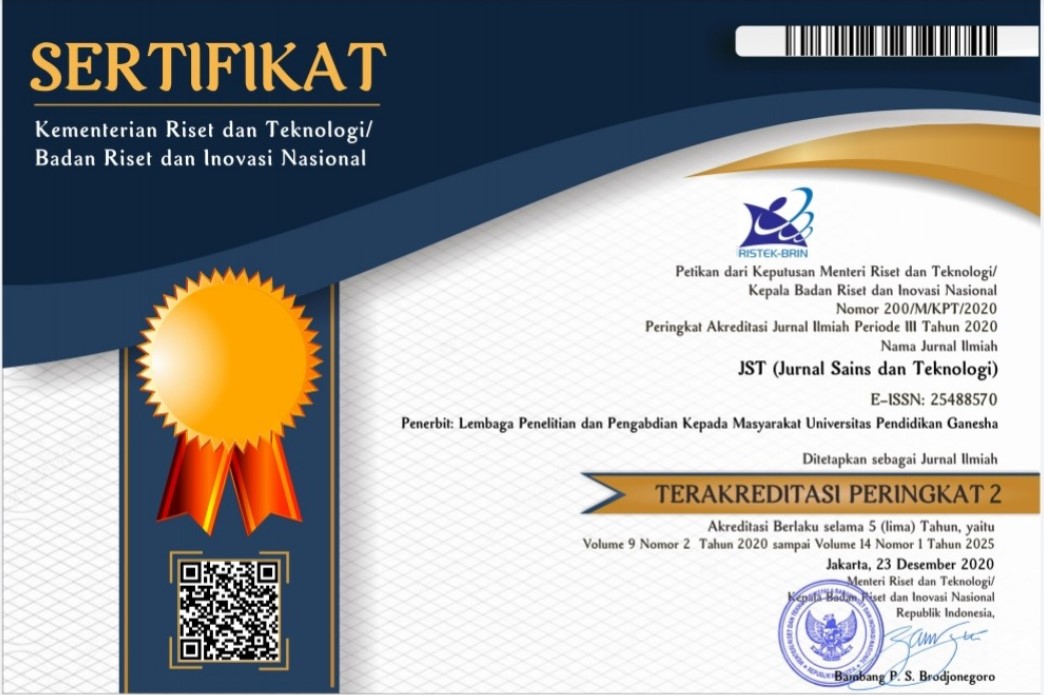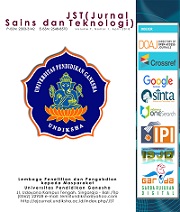Design Virtual Tour Technology Application to Improve Digital Literacy of Teachers and Students About Edu-tourism
DOI:
https://doi.org/10.23887/jstundiksha.v13i2.83962Keywords:
Virtual Reality, eduwisata, application, 3D Objects, EducationAbstract
More technological innovation in the tourism sector must be integrated with educational aspects and digital literacy, especially during a pandemic that limits physical visits to tourist attractions. Although several tourism applications have been developed, only a few have been specifically designed to improve digital literacy and visitor knowledge in terms of educational content and integration with the school curriculum. This research aims to create a virtual tour-based edu-tourism application that is packaged with virtual reality applications. This research is a research and development using the ADDIE model. The subjects of this research were randomly 250 teachers and high school / vocational school students. The data collection method was a questionnaire using an instrument in the form of an instrument sheet. After the data was collected, it was analyzed using quantitative and qualitative descriptive data analysis methods. The results showed that the design of the virtual tour technology application received a very good assessment in the aspects of media, material, discussion, and display. This is also in line with the teacher's response, which assessed these aspects positively, with the highest score given to the media aspect, followed by the material, discussion, and display. This study concludes that the virtual tour-based eduwisata application packaged with virtual reality applications is effective in improving the literacy skills of teachers and students regarding eduwisata. The results of this study indicate that virtual tour applications can be implemented as interactive learning media that can improve student and teacher literacy in the field of edu-tourism.
References
Akugizibwe, E. (2020). Perspectives for effective integration of e-learning tools in university mathematics instruction for developing countries. Education and Information Technologies, 25(2), 889–903. https://doi.org/10.1007/s10639-019-09995-z. DOI: https://doi.org/10.1007/s10639-019-09995-z
Alturki, S. (2021). Using Educational Data Mining To Predict Students’ Academic Performance For Applying Early Interventions. Journal of Information Technology Education: Innovations in Practice, 20, 121–137. https://doi.org/10.28945/4835. DOI: https://doi.org/10.28945/4835
Bouwer, R. (2018). Applying Criteria to Examples or Learning by Comparison: Effects on Students’ Evaluative Judgment and Performance in Writing. Frontiers in Education, 3. https://doi.org/10.3389/feduc.2018.00086. DOI: https://doi.org/10.3389/feduc.2018.00086
Buchori, A., . S., & Septia Devega, L. (2024). The Effect of Using Interactive Multimedia Design with the STEM VR Approach to Strengthening Pancasila Student Profiles in Elementary School. KnE Social Sciences, 2024, 634–641. https://doi.org/10.18502/kss.v9i6.15317. DOI: https://doi.org/10.18502/kss.v9i6.15317
Buchori, A., Prasetyowati, D., & Wijayanto. (2024). The Influence of Using Virtual Reality (VR)-Based Geometry Lab media on Student Learning Achievement at UIN Walisongo Semarang. International Journal of Religion, 5(5), 485–493. https://doi.org/10.61707/2r9r7c30. DOI: https://doi.org/10.61707/2r9r7c30
Cai, J. (2020). Literacy and Digital Problem -solving Skills in the 21st Century: What PIAAC Says about Educators in the United States, Canada, Finland and Japan. Teaching Education, 31(2), 177–208. https://doi.org/10.1080/10476210.2018.1516747. DOI: https://doi.org/10.1080/10476210.2018.1516747
Drivas, T. (2022). Introducing the Fundamentals of Artificial Intelligence to K-12 Classrooms According to Educational Neuroscience Principles. In 7th South-East Europe Design Automation, Computer Engineering, Computer Networks and Social Media Conference, SEEDA-CECNSM 2022. https://doi.org/10.1109/SEEDA-CECNSM57760.2022.9932989. DOI: https://doi.org/10.1109/SEEDA-CECNSM57760.2022.9932989
Finansyah, A. Y. W., Afiahayati, F., & Sutanto, V. M. (2022). Performance Comparison of Similarity Measure Algorithm as Data Preprocessing Stage: Text Normalization in Bahasa. Scientific Journal of Informatics, 9(1), 1–7. https://doi.org/10.15294/sji.v9i1.30052. DOI: https://doi.org/10.15294/sji.v9i1.30052
Gudmundsdottir, G. B., & Hatlevik, O. E. (2018). Newly qualified teachers’ professional digital competence: implications for teacher education. European Journal of Teacher Education, 41(2), 214–231. https://doi.org/10.1080/02619768.2017.1416085. DOI: https://doi.org/10.1080/02619768.2017.1416085
Haiyudi, H., & Art-In, S. (2021). Challenges, Strategies, and Solutions of Teaching Bahasa Indonesia in Covid-19 Crises: Case in Khon Kaen University. Indonesian Journal on Learning and Advanced Education (IJOLAE), 3(2), 142–152. https://doi.org/10.23917/ijolae.v3i2.12369. DOI: https://doi.org/10.23917/ijolae.v3i2.12369
Junyu Lu Xiao Xiao, Z. X. C. W. M. Z., & Zhou, Y. (2022). The potential of virtual tourism in the recovery of tourism industry during the COVID-19 pandemic. Current Issues in Tourism, 25(3), 441–457. https://doi.org/10.1080/13683500.2021.1959526. DOI: https://doi.org/10.1080/13683500.2021.1959526
Kinseng, R. A. (2022). COVID-19 and the emergence of virtual tourism in Indonesia: A sociological perspective. Cogent Social Sciences, 8(1). https://doi.org/10.1080/23311886.2022.2026557. DOI: https://doi.org/10.1080/23311886.2022.2026557
Kong, S. C. (2024). A Human-Centred Learning and Teaching Framework Using Generative Artificial Intelligence for Self-Regulated Learning Development through Domain Knowledge Learning in K–12 Settings. IEEE Transactions on Learning Technologies. https://doi.org/10.1109/TLT.2024.3392830. DOI: https://doi.org/10.1109/TLT.2024.3392830
Listyorini, T., Umam, M. K., & Riadi, A. A. (2022). 3D Animation Making Crafts Monel Jepara. Scientific Journal of Informatics, 9(1), 16–22. https://doi.org/10.15294/sji.v9i1.31686. DOI: https://doi.org/10.15294/sji.v9i1.31686
Liu, T. (2023). Exploration on the Integration of New Generation Information Technology and Curriculum Ideological and Political Under the Background of CEC Education Model. In Learning and Analytics in Intelligent Systems (Vol. 31, pp. 213–221). https://doi.org/10.1007/978-3-031-29016-9_20. DOI: https://doi.org/10.1007/978-3-031-29016-9_20
Liu, Y. (2021). Application of Flipped Classroom in the Era of Big Data: What Factors Influence the Effect of Teacher-Student Interaction in Oral English Teaching. Wireless Communications and Mobile Computing, 2021. https://doi.org/10.1155/2021/4966974. DOI: https://doi.org/10.1155/2021/4966974
Long, D. (2021). The Role of Collaboration, Creativity, and Embodiment in AI Learning Experiences. In ACM International Conference Proceeding Series. https://doi.org/10.1145/3450741.3465264. DOI: https://doi.org/10.1145/3450741.3465264
Memarian, B. (2024). Teaching and learning artificial intelligence: Insights from the literature. Education and Information Technologies. https://doi.org/10.1007/s10639-024-12679-y. DOI: https://doi.org/10.1007/s10639-024-12679-y
Nurwiatin, N. (2022). Pengaruh pengembangan kurikulum merdeka belajar dan kesiapan kepala sekolah terhadap penyesuaian pembelajaran di sekolah. In … Pendidikan, Sains Dan Teknologi. journalstkippgrisitubondo.ac.id. DOI: https://doi.org/10.47668/edusaintek.v9i2.537
Partarakis, N. (2024). A Review of Immersive Technologies, Knowledge Representation, and AI for Human-Centered Digital Experiences. In Electronics (Switzerland) (Vol. 13, Issue 2). https://doi.org/10.3390/electronics13020269. DOI: https://doi.org/10.3390/electronics13020269
Rukiyati, Hanum, F., & Andriani Purwastuti, L. (2023). Excellence of the diversity value and the educational environment on student nationalism. Cakrawala Pendidikan, 42(2), 364–379. https://doi.org/10.21831/cp.v42i2.55797. DOI: https://doi.org/10.21831/cp.v42i2.55797
Sanjaya, K. O., & Mahendra, G. S. (2024). Dokumentasi Pelestarian Objek Wisata Candi Tebing Gunung Kawi Menggunakan Platform Video 360. JST (Jurnal Sains Dan Teknologi), 12(3), 646–655. https://doi.org/10.23887/jstundiksha.v12i3.39127. DOI: https://doi.org/10.23887/jstundiksha.v12i3.39127
Schleiss, J. (2023). AI Course Design Planning Framework: Developing Domain-Specific AI Education Courses. Education Sciences, 13(9). https://doi.org/10.3390/educsci13090954. DOI: https://doi.org/10.3390/educsci13090954
Singhal, R. (2021). Digital device-based active learning approach using virtual community classroom during the COVID-19 pandemic. Computer Applications in Engineering Education, 29(5), 1007–1033. https://doi.org/10.1002/cae.22355. DOI: https://doi.org/10.1002/cae.22355
Sudana, O., Sukma, K. V. M., Wirdiani, A., & Putri, G. A. A. (2024). E-Dharmagita Learning Model Innovation with Mobile and Multimedia Technology. Scientific Journal of Informatics, 11(1), 41–52. https://doi.org/10.15294/sji.v11i1.46653. DOI: https://doi.org/10.15294/sji.v11i1.46653
Sugiyono. (2017). MetodePenelitian Kuantitatif, Kualitatif dan R&D. Bandung: PT Alfabet. In Sugiyono. (2017). MetodePenelitian Kuantitatif, Kualitatif dan R&D. Bandung: PT Alfabet.
Suprapto, Y. (2021). The Marketing Strategy During Covid 19 Pandemic at Hotels in Parapat Area, Simalungun Regency, North Sumatera, Indonesia. THCIJ (Tourism, Hospitality and Culture Insights Journal), 1(1), 1–23. https://doi.org/10.36983/thcij.v1i1.270. DOI: https://doi.org/10.36983/thcij.v1i1.270
Suwardika, G., Suniantara, I. K. P., & Masakazu, K. (2024). SEM - PLS in the WebQual 4.0 Method for Enhancing the Quality of Online Tutorial Learning Applications at Open Universities. JST (Jurnal Sains Dan Teknologi), 12(3), 703–713. https://doi.org/10.23887/jstundiksha.v12i3.68789. DOI: https://doi.org/10.23887/jstundiksha.v12i3.68789
Swaid, S. (2019). Computational thinking education: Who let the dog out? In Proceedings - 6th Annual Conference on Computational Science and Computational Intelligence, CSCI 2019 (pp. 788–792). https://doi.org/10.1109/CSCI49370.2019.00150. DOI: https://doi.org/10.1109/CSCI49370.2019.00150
Tju, T. E. E., & Tamatjita, E. N. (2024). Smart System on Two-dimensional Shapes Recognition Application for Kindergarten Students. Scientific Journal of Informatics, 11(1), 53–60. https://doi.org/10.15294/sji.v11i1.47494. DOI: https://doi.org/10.15294/sji.v11i1.47494
Tombeng, M., Walansendow, A., & ... (2024). Analisis Dampak Covid-19 di Era Pasca Covid pada Operasional Penerbangan di Bandar Udara Sam Ratulangi Manado. Jurnal Ilmu …, 30(5). http://stpmanado.ac.id/jurhos/index.php/jip/article/view/69%0Ahttps://stpmanado.ac.id/jurhos/index.php/jip/article/download/69/56.
Tuasikal, A. R. S., Hartoto, S., Prakoso, B. B., Kartiko, D. C., & Hariyanto, A. (2021). the Analysis on Teaching Skills and Learning Effectiveness of Internship Students. Cakrawala Pendidikan, 40(3), 650–658. https://doi.org/10.21831/cp.v40i3.40466. DOI: https://doi.org/10.21831/cp.v40i3.40466
Udiono, T. (2022). Digital Batik Village Based on Virtual Tour as an Alternative for Batik Promotion in Indonesia Especially Pekalongan City. International Journal of Applied Engineering and Technology (London), 4(2), 124–129.
Valor, C. (2020). The relationship between moral competences and sustainable consumption among higher education students. Journal of Cleaner Production, 248. https://doi.org/10.1016/j.jclepro.2019.119161. DOI: https://doi.org/10.1016/j.jclepro.2019.119161
Yaelasari, M., & Astuti, V. Y. (2022). Implementasi Kurikulum Merdeka Pada Cara Belajar Siswa Untuk Semua Mata Pelajaran (Studi Kasus Pembelajaran Tatap Muka di SMK INFOKOM Bogor). Jurnal Pendidikan Indonesia. DOI: https://doi.org/10.36418/japendi.v3i7.1041
Yusa, I. M. M., Priyono, D., Anggara, I. G. A. S., Setiawan, I. N. A. F., Yasa, I. W. A. P., Yasa, N. P. D., Novitasari, D., Mutiarani, R. A., Rizaq, M. C., Jayanegara, I. N., & others. (2023). Buku Ajar desain Komunikasi Visual (DKV). PT. Sonpedia Publishing Indonesia. https://books.google.co.id/books?id=Mr3lEAAAQBAJ.
Zhao, F. (2023). Construction and Practice of Smart Teaching System Based on Artificial Intelligence. In ACM International Conference Proceeding Series (pp. 528–533). https://doi.org/10.1145/3638884.3638967. DOI: https://doi.org/10.1145/3638884.3638967
Downloads
Published
How to Cite
Issue
Section
License
Copyright (c) 2024 Muh Isna Nurdin Wibisana, Maryanto Maryanto, Achmad Buchori, Utvi Hinda Zhannisa

This work is licensed under a Creative Commons Attribution-ShareAlike 4.0 International License.
Authors who publish with the Jurnal Sains dan Teknologi (JST) agree to the following terms:
- Authors retain copyright and grant the journal the right of first publication with the work simultaneously licensed under a Creative Commons Attribution License (CC BY-SA 4.0) that allows others to share the work with an acknowledgment of the work's authorship and initial publication in this journal.
- Authors are able to enter into separate, additional contractual arrangements for the non-exclusive distribution of the journal's published version of the work (e.g., post it to an institutional repository or publish it in a book), with an acknowledgment of its initial publication in this journal.
- Authors are permitted and encouraged to post their work online (e.g., in institutional repositories or on their website) prior to and during the submission process, as it can lead to productive exchanges, as well as earlier and greater citation of published work. (See The Effect of Open Access)















